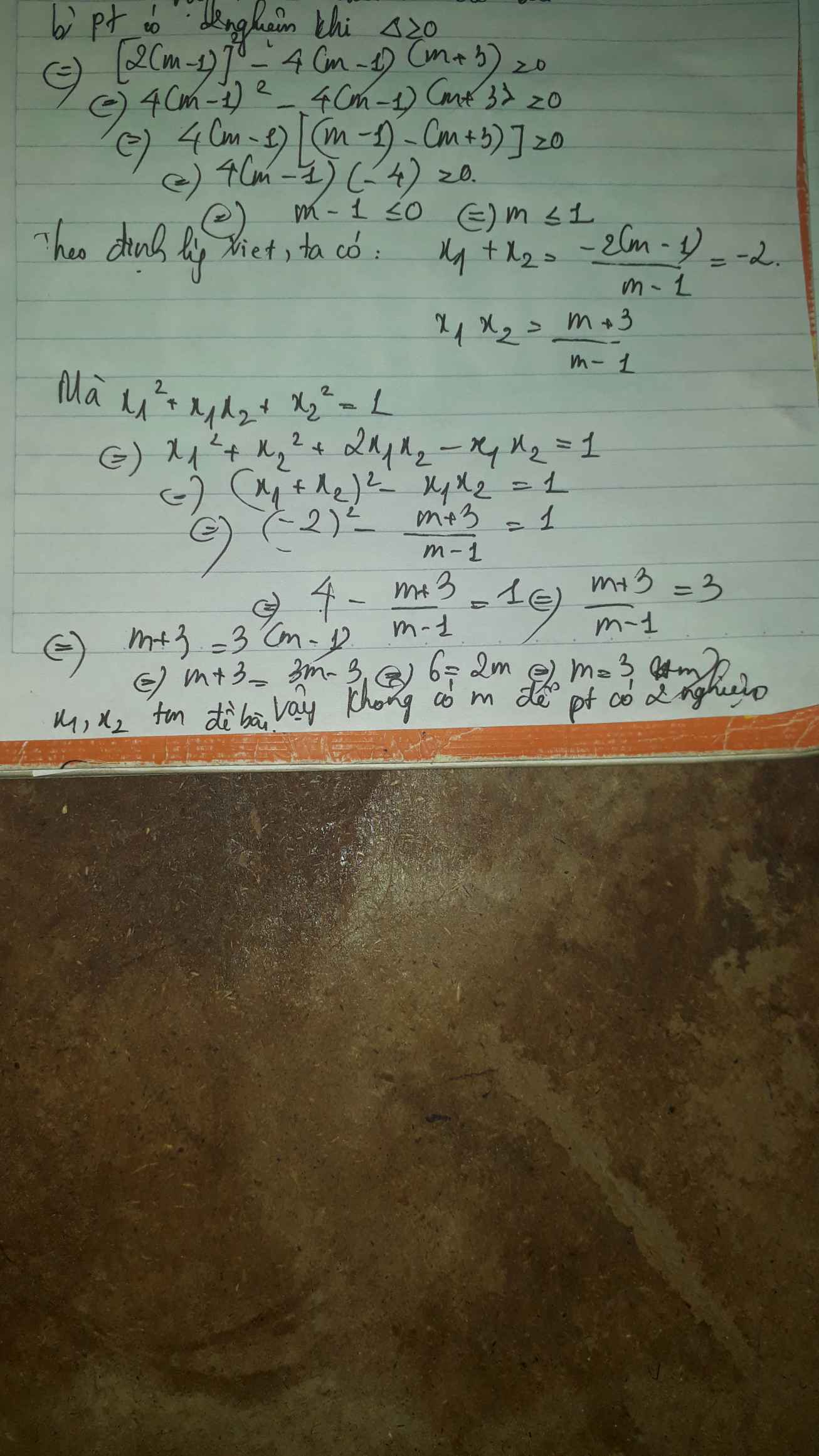Tìm m để phương trình \(-x^2+2\left(m-1\right)x+m-3=0\) có hai nghiệm phân biệt
Hãy nhập câu hỏi của bạn vào đây, nếu là tài khoản VIP, bạn sẽ được ưu tiên trả lời.


d: Ta có: \(\text{Δ}=\left(m+1\right)^2-4\cdot2\cdot\left(m+3\right)\)
\(=m^2+2m+1-8m-24\)
\(=m^2-6m-23\)
\(=m^2-6m+9-32\)
\(=\left(m-3\right)^2-32\)
Để phương trình có hai nghiệm phân biệt thì \(\left(m-3\right)^2>32\)
\(\Leftrightarrow\left[{}\begin{matrix}m-3>4\sqrt{2}\\m-3< -4\sqrt{2}\end{matrix}\right.\Leftrightarrow\left[{}\begin{matrix}m>4\sqrt{2}+3\\m< -4\sqrt{2}+3\end{matrix}\right.\)
Áp dụng hệ thức Vi-et, ta được:
\(\left\{{}\begin{matrix}x_1+x_2=\dfrac{m+1}{2}\\x_1x_2=\dfrac{m+3}{2}\end{matrix}\right.\)
Ta có: \(\left\{{}\begin{matrix}x_1+x_2=\dfrac{m+1}{2}\\x_1-x_2=1\end{matrix}\right.\Leftrightarrow\left\{{}\begin{matrix}2x_1=\dfrac{m+3}{2}\\x_2=x_1-1\end{matrix}\right.\)
\(\Leftrightarrow\left\{{}\begin{matrix}x_1=\dfrac{m+3}{4}\\x_2=\dfrac{m+3}{4}-\dfrac{4}{4}=\dfrac{m-1}{4}\end{matrix}\right.\)
Ta có: \(x_1x_2=\dfrac{m+3}{2}\)
\(\Leftrightarrow\dfrac{\left(m+3\right)\left(m-1\right)}{16}=\dfrac{m+3}{2}\)
\(\Leftrightarrow\left(m+3\right)\left(m-1\right)=8\left(m+3\right)\)
\(\Leftrightarrow\left(m+3\right)\left(m-9\right)=0\)
\(\Leftrightarrow\left[{}\begin{matrix}m=-3\\m=9\end{matrix}\right.\)

b) phương trình có 2 nghiệm \(\Leftrightarrow\Delta'\ge0\)
\(\Leftrightarrow\left(m-1\right)^2-\left(m-1\right)\left(m+3\right)\ge0\)
\(\Leftrightarrow m^2-2m+1-m^2-3m+m+3\ge0\)
\(\Leftrightarrow-4m+4\ge0\)
\(\Leftrightarrow m\le1\)
Ta có: \(x_1^2+x_1x_2+x_2^2=1\)
\(\Leftrightarrow\left(x_1+x_2\right)^2-2x_1x_2=1\)
Theo viet: \(\left\{{}\begin{matrix}x_1+x_2=-\dfrac{b}{a}=2\left(m-1\right)\\x_1x_2=\dfrac{c}{a}=m+3\end{matrix}\right.\)
\(\Leftrightarrow\left[-2\left(m-1\right)^2\right]-2\left(m+3\right)=1\)
\(\Leftrightarrow4m^2-8m+4-2m-6-1=0\)
\(\Leftrightarrow4m^2-10m-3=0\)
\(\Leftrightarrow\left[{}\begin{matrix}m_1=\dfrac{5+\sqrt{37}}{4}\left(ktm\right)\\m_2=\dfrac{5-\sqrt{37}}{4}\left(tm\right)\end{matrix}\right.\Rightarrow m=\dfrac{5-\sqrt{37}}{4}\)

\(\text{Δ}=\left(-8\right)^2-4\cdot\left(-3\right)\cdot\left(m-1\right)\)
\(=64+12\left(m-1\right)\)
=64+12m-12
=12m+52
a: Để phương trình có hai nghiệm phân biệt nhỏ hơn 7 thì
\(\left\{{}\begin{matrix}12m+52>0\\8< 14\end{matrix}\right.\Leftrightarrow m>-\dfrac{13}{4}\)
b: Để phương trình có hai nghiệm phân biệt lớn hơn 7 thì \(\left\{{}\begin{matrix}12m+52>0\\8>14\end{matrix}\right.\Leftrightarrow m\in\varnothing\)

Để phương trình có 2 nghiệm phân biệt
\(\Delta=\left(2-m\right)^2-4.1.\left(m-3\right)>0\Leftrightarrow m^2-4m+4-4m+12>0\)
\(\Leftrightarrow m^2-8m+16>0\Leftrightarrow\left(m-4\right)^2>0\Leftrightarrow m-4\ne0\Leftrightarrow m\ne4\)
Thấy : \(1+\left(2-m\right)+m-3=0\)
-> phương trình có nghiệm là 1
Th1 : \(x_1=1;x_2=\dfrac{c}{a}=m-3\)
\(\left|x_1\right|+x_2^2=2\Leftrightarrow\left|1\right|+\left(m-3\right)^2=2\)
\(\Leftrightarrow\left(m-3\right)^2=1\Leftrightarrow\)\(\left\{{}\begin{matrix}m-3=1\\m-3=-1\end{matrix}\right.\Leftrightarrow\left\{{}\begin{matrix}m=4\left(L\right)\\m=2\left(C\right)\end{matrix}\right.\)
TH2 : \(x_1=\dfrac{c}{a}=m-1;x_2=1\)
\(\Leftrightarrow\left|m-1\right|+1^2=2\Leftrightarrow\left|m-1\right|=1\)
hoàn toàn giống với th1.
Vậy \(m=2\)
Ôi e ơi, sao mà làm kiểu: Thấy... như này được
\(\Delta>0\Leftrightarrow m\ne4\)
Phương trình có hai nghiệm\(\left[{}\begin{matrix}x=\dfrac{-\left(2-m\right)-\left(m-4\right)}{2}=1\\x=\dfrac{-\left(2-m\right)+\left(m-4\right)}{2}=m-3\end{matrix}\right.\)
Sau đó chia trường hợp

Trường hợp 1: m=10
Phương trình sẽ là -40x+6=0
hay x=3/20
=>m=10 sẽ thỏa mãn trường hợp a
Trường hợp 2: m<>10
\(\Delta=\left(-4m\right)^2-4\left(m-10\right)\left(m-4\right)\)
\(=16m^2-4\left(m^2-14m+40\right)\)
\(=16m^2-4m^2+56m-160\)
\(=12m^2+56m-160\)
\(=4\left(3m^2+14m-40\right)\)
\(=4\left(3m^2-6m+20m-40\right)\)
\(=4\left(m-2\right)\left(3m+20\right)\)
a: Để phương trình có nghiệm thì (m-2)(3m+20)>=0
=>m>=2 hoặc m<=-20/3
b: Để phương trình có hai nghiệm phân biệt đều dương thì
\(\left\{{}\begin{matrix}\left(m-2\right)\left(3m+20\right)>0\\\dfrac{4m}{m-10}>0\\\dfrac{m-4}{m-10}>0\end{matrix}\right.\Rightarrow\left\{{}\begin{matrix}\left(m-2\right)\left(3m+20\right)>0\\m\in\left(-\infty;0\right)\cup\left(10;+\infty\right)\\m\in\left(-\infty;4\right)\cup\left(10;+\infty\right)\end{matrix}\right.\)
\(\Leftrightarrow m\in\left(-\infty;-\dfrac{20}{3}\right)\cup\left(10;+\infty\right)\)

\(mx^2+2\left(m-1\right)x+m+3=0\)(Đk:m≠0)
\(\Delta'=\left(m-1\right)^2-m\left(m+3\right)\)
\(\Delta'=m^2-2m+1-m^2-3m\)
\(\Delta'=1-5m\)
a,Để pt có nghiệm kép
Thì\(\Delta'=0\)
\(\Leftrightarrow1-5m=0\Rightarrow m=\dfrac{1}{5}\)
b, Để pt có 2 nghiệm phân biệt
Thì\(\Delta'>0\)
\(\Leftrightarrow1-5m>0\Rightarrow m< \dfrac{1}{5}\)
c,Để pt có nghiệm
Thì\(\Delta'\ge0\)
\(\Leftrightarrow1-5m\ge0\Rightarrow m\le\dfrac{1}{5}\)
d, Để pt vô nghiệm
Thì\(\Delta'< 0\)
\(\Leftrightarrow1-5m< 0\Rightarrow m>\dfrac{1}{5}\)
Lời giải:
$m=0$ thì pt trở thành $-2x+3=0\Leftrightarrow x=\frac{3}{2}$
$m\neq 0$ thì pt là pt bậc 2 ẩn $x$
$\Delta'=(m-1)^2-m(m+3)=1-5m$
PT có nghiệm kép $\Leftrightarrow \Delta'=1-5m=0\Leftrightarrow m=\frac{1}{5}$
PT có 2 nghiệm pb $\Leftrightarrow \Delta'=1-5m>0$
$\Leftrightarrow m< \frac{1}{5}$
Vậy pt có 2 nghiệm pb khi $m< \frac{1}{5}$ và $m\neq 0$
PT có nghiệm khi \(\left[\begin{matrix} m=0\\ \Delta'=1-5m\geq 0\end{matrix}\right.\Leftrightarrow \left[\begin{matrix} m=0\\ m\leq \frac{1}{5}\end{matrix}\right.\Leftrightarrow m\leq \frac{1}{5}\)
PT vô nghiệm khi $\Delta'=1-5m< 0$
$\Leftrightarrow m> \frac{1}{5}$

\(\Delta'=\left(m+1\right)^2-\left(m^2+2m\right)=1>0\)
\(\Rightarrow\) Phương trình luôn có 2 nghiệm: \(\left\{{}\begin{matrix}x_1=m+1-1=m\\x_2=m+1+1=m+2\end{matrix}\right.\)
\(\left|x_1\right|=3\left|x_2\right|\Leftrightarrow\left|m\right|=3\left|m+2\right|\)
\(\Leftrightarrow\left[{}\begin{matrix}3m+6=-m\\3m+6=m\end{matrix}\right.\) \(\Rightarrow\left[{}\begin{matrix}m=-\dfrac{3}{2}\\m=-3\end{matrix}\right.\)

Phương trình có 2 nghiệm pb khi:
\(\Delta'=\left(m-1\right)^2+m-3>0\)
\(\Leftrightarrow m^2-m-2>0\)
\(\Rightarrow\left[{}\begin{matrix}m< -1\\m>2\end{matrix}\right.\)